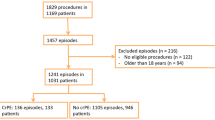Abstract
Postoperative atrial fibrillation is a poor prognostic factor associated with increased mortality rates. Patients experiencing significant pericardial effusion develop postoperative atrial fibrillation; however, little is explored about the association between postoperative atrial fibrillation and post-cardiotomy pericardial effusion. This retrospective, single-center study included adult patients who underwent cardiovascular surgery via median sternotomy from January 2016 to December 2019. Patients who underwent routine postoperative computed tomography at 7 ± 3 days after surgery (n = 294) were included. Pericardial effusion was measured at the thickest point. Patients were classified into those with (n = 127) and without (n = 167) postoperative atrial fibrillation. The association of pericardial effusion with other factors was evaluated. A possible confounder-adjusted logistic regression analysis after multiple imputation was performed to obtain odds ratios for postoperative atrial fibrillation using previously published risk factors. Age, intraoperative bleeding volume, and pericardial effusion size were all significantly higher in the group with postoperative atrial fibrillation. Multivariate logistic regression after multiple imputation revealed that age, intraoperative bleeding volume, and postoperative pericardial effusion were significantly associated with postoperative atrial fibrillation. Our findings suggest that post-cardiotomy pericardial effusion is associated with postoperative atrial fibrillation. However, the causality remains unknown, making further studies mandatory.




Similar content being viewed by others
References
Greenberg JW, Lancaster TS, Schuessler RB, Melby SJ (2017) Postoperative atrial fibrillation following cardiac surgery: a persistent complication. Eur J Cardiothorac Surg 52:665–672
Kowey PR, Stebbins D, Igidbashian L, Goldman SM, Sutter FP, Rials SJ, Marinchak RA (2001) Clinical outcome of patients who develop PAF after CABG surgery. Pacing Clin Electrophysiol 24:191–193
Royster RL, Deng H, Whalen SP (2017) Postoperative atrial fibrillation. Anesth Analg 125:10–12
Melduni RM, Schaff HV, Bailey KR, Cha SS, Ammash NM, Seward JB, Gersh BJ (2015) Implications of new-onset atrial fibrillation after cardiac surgery on long-term prognosis: a community-based study. Am Heart J 170:659–668
Funk M, Richards SB, Desjardins J, Bebon C, Wilcox H (2003) Incidence, timing, symptoms, and risk factors for atrial fibrillation after cardiac surgery. Am J Crit Care 12:424–435
Dobrev D, Aguilar M, Heijman J, Guichard JB, Nattel S (2019) Postoperative atrial fibrillation: mechanisms, manifestations and management. Nat Rev Cardiol 16:417–436
Eikelboom R, Sanjanwala R, Le ML, Yamashita MH, Arora RC (2021) Postoperative atrial fibrillation after cardiac surgery: a systematic review and meta-analysis. Ann Thorac Surg 111:544–554
Olesen OJ, Vinding NE, Østergaard L, Butt JH, Gislason GH, Torp-Pedersen C, Køber L, Fosbøl EL (2020) C-reactive protein after coronary artery bypass graft surgery and its relationship with postoperative atrial fibrillation. Europace 22:1182–1188
Kaygin MA, Daǧ Ö, Güneş M, Senocak M, Limandal HK, Aslan U, Erkut B (2011) Posterior pericardiotomy reduces the incidence of atrial fibrillation, pericardial effusion, and length of stay in hospital after coronary artery bypasses surgery. Tohoku J Exp Med 225:103–108
Chua SK, Shyu KG, Lu MJ, Lien LM, Lin CH, Chao HH, Lo HM (2013) Clinical utility of CHADS2 and CHA2DS 2-VASc scoring systems for predicting postoperative atrial fibrillation after cardiac surgery. J Thorac Cardiovasc Surg 146:919-926.e1
Chen L, Du X, Dong J, Ma CS (2018) Performance and validation of a simplified postoperative atrial fibrillation risk score. Pacing Clin Electrophysiol 41:1136–1142
Steinberg BA, Zhao Y, He X, Hernandez AF, Fullerton DA, Thomas KL, Mills R, Klaskala W, Peterson ED, Piccini JP (2014) Management of postoperative atrial fibrillation and subsequent outcomes in contemporary patients undergoing cardiac surgery: Insights from the society of thoracic surgeons CAPS-Care atrial fibrillation registry. Clin Cardiol 37:7–13
Kanda Y (2013) Investigation of the freely available easy-to-use software ‘EZR’ for medical statistics for medical statistics. Bone Marrow Transplant 48:452–458
Nguyen HS, Nguyen HDT, Vu TD (2018) Pericardial effusion following cardiac surgery. A single-center experience. Asian Cardiovasc Thorac Ann 26:5–10
Imazio M, Brucato A, Ferrazzi P et al (2014) Colchicine for prevention of postpericardiotomy syndrome and postoperative atrial fibrillation: The COPPS-2 randomized clinical trial. JAMA 312:1016–1023
Rowan SB, Krantz MJ (2006) Paradoxical decrease in blood pressure after relief of cardiac tamponade: the role of sympathetic activity. Med Sci Monit 12:CS16-19
Prabhu S, Voskoboinik A, Kaye DM, Kistler PM (2017) Atrial fibrillation and heart failure—cause or effect? Heart Lung Circ 26:967–974
Regueiro A, Falces C, Pericás JM et al (2018) Risk factors of pericardial effusion in native valve infective endocarditis and its influence on outcome: a multicenter prospective cohort study. Int J Cardiol 273:193–198
Akintoye E, Sellke F, Marchioli R, Tavazzi L, Mozaffarian D (2018) Factors associated with postoperative atrial fibrillation and other adverse events after cardiac surgery. J Thorac Cardiovasc Surg 155:242-251.e10
Funding
None.
Author information
Authors and Affiliations
Corresponding author
Ethics declarations
Conflict of interest
The authors have no conflicts of interest directly relevant to the content of this article.
Ethical approval
The study was approved by the Institutional Review Board of Asahikawa Medical University. Date: 20. April. 2021, Approval Number: 20107.
Informed consent
Owing to the retrospective design, the requirement for informed patient consent was waived.
Additional information
Publisher's Note
Springer Nature remains neutral with regard to jurisdictional claims in published maps and institutional affiliations.
Rights and permissions
About this article
Cite this article
Kikuchi, Y., Saijo, Y., Narita, M. et al. Post-cardiotomy pericardial effusion and postoperative atrial fibrillation risk. Int J Cardiovasc Imaging 38, 1873–1879 (2022). https://doi.org/10.1007/s10554-022-02560-9
Received:
Accepted:
Published:
Issue Date:
DOI: https://doi.org/10.1007/s10554-022-02560-9




